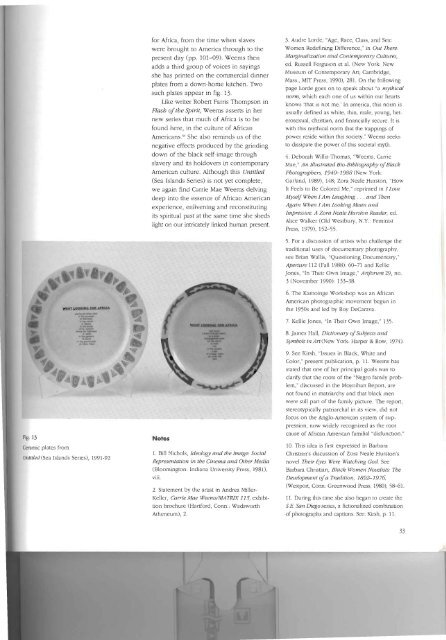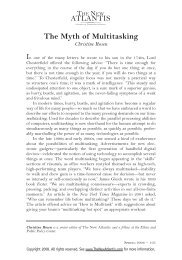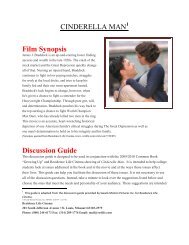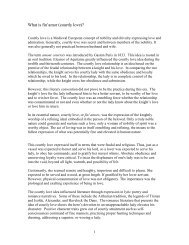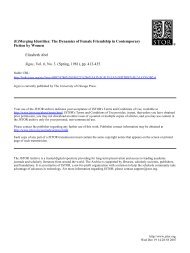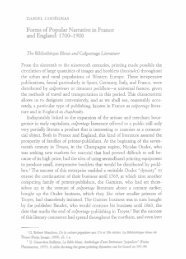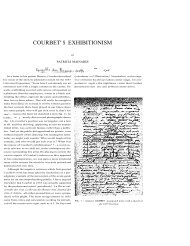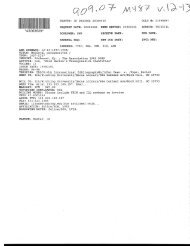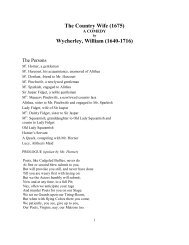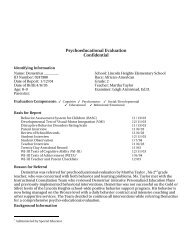CARRIE MAE WEEMS - People Search Directory
CARRIE MAE WEEMS - People Search Directory
CARRIE MAE WEEMS - People Search Directory
Create successful ePaper yourself
Turn your PDF publications into a flip-book with our unique Google optimized e-Paper software.
for Africa, from the time when slaves<br />
were brought to America through to the<br />
present day (pp, 101--09). Weems then<br />
adds a third group of voices in sayings<br />
she has printed on the commercial dinner<br />
plates from a down-home kitchen, Two<br />
such plates appear in fig. 13,<br />
Like writer Robert Farris Thompson in<br />
Flash ofthe SPirit, Weems asserts in her<br />
new series that much of Africa is to be<br />
found here, in the culture of African<br />
Americans'" She also reminds us of the<br />
negative effects produced by the grinding<br />
down of the black self-image through<br />
slavery and its holdovers in contemporary<br />
American culture, Although this Untitled<br />
(Sea Islands Series) is not yet complete,<br />
we again find Carrie Mae Weems delving<br />
deep into the essence of African American<br />
experience, enlivening and reconstituting<br />
its spiritual past at the same time she sheds<br />
light on our intricately linked human present.<br />
3. Audre Lorde, "Age, Race, Class, and Sex:<br />
Women Redefining Difference," in Out There'<br />
Marginalization and Contemporary Cultures,<br />
ed, Russell Fergl.lS0n et aL (New York: New<br />
Museum of Contemporary Art; Cambridge,<br />
Mass., MIT Press, 1990), 281, On the following<br />
page Lorde goes on to speak about "a mythical<br />
norm, which each one of us within our hearts<br />
knows 'that is not me,' In america, this norm is<br />
usually defined as white, thin, male, young, heterosexual,<br />
christian, and financially secure, It is<br />
with this mythical norm that the trappings of<br />
power reside within this society," Weems seeks<br />
to dissipate the power of this societal myth<br />
4, Deborah WilliS-Thomas, "Weems, Carrie<br />
Mae," An Illustrated Bio-Bibliography ojBlack<br />
Photographers, 194().-i988 (New York:<br />
Garland, 1989), 148; Zora Neale Hurston, "How<br />
It Feels to Be Colored Me," reprinted in I Love<br />
MyselJWhen I Am Laughing , and Then<br />
Again When I Am Looking Mean and<br />
Impressive, A 20ra Neale Hurston Reader, ed,<br />
Alice Walker (Old WestbulY, NY Feminist<br />
Press, 1979), 152-55<br />
Fig. 13<br />
Ceramic plates from<br />
Untitled(Sea Islands Series), 1991-92<br />
Notes<br />
1. Bill Nichols, Ideology and the image: Social<br />
Representation in the Cinema and Other Media<br />
(Bloomington: Indiana University Press, 1981),<br />
viii.<br />
2. Statement by the artist in Andrea Miller<br />
Keller, Carrie Mae Weems/MATRIX 115, exhibition<br />
brochure (Hartford, Conn.: Wadsworth<br />
Atheneum), 2.<br />
5. For a discussion of artists who challenge the<br />
traditional uses of documentary photography,<br />
see Brian Wallis, "Questioning Documentary,"<br />
Aperture 112 (Fall 1988): 60--71 and Kellie<br />
Jones, "In Their Own Image," AI1Jorum 29, no,<br />
3 (November 1990): 133-38,<br />
6. The Kamoinge Workshop was an African<br />
American photographic movement begun in<br />
the 1950s and led by Roy DeCarava,<br />
7 Kellie Jones, "In TIleir Own Image," 135,<br />
8. James Hall, Dictionary ojSUhjects and<br />
Symbols inAl1 (New York Harper & Row, 1974).<br />
9, See Kirsh, "Issues in Black, White and<br />
Color," present pUblication, p, 11. Weems has<br />
stated that one of her principal goa.ls was to<br />
clarify that the roots of the "Negro family problem,"<br />
discussed in the iv[oynlhan Report, are<br />
not found in matriarchy and that black men<br />
were still part of the family picture, The repor1,<br />
stereotypically patriarchal in its view, did not<br />
foclls on the Anglo-American system of suppreSSion,<br />
now widely recognized as the root<br />
cause of African American familial "disfunction,"<br />
10. This idea is first expressed in Barbara<br />
Christian's discussion of Zora Neale Hurston's<br />
novel Their Eyes Were Watching God. See<br />
Barbara Christian, Black Women Novelists' The<br />
Development oja Tradition, 1892-1976,<br />
(Westport, Conn: Greenwood Press, 1980), 58-Q1.<br />
11, DUling this time she also began to create the<br />
SE San Diego series, a fictionalized combination<br />
of photographs and captions, See: Kirsh, p, 11.<br />
33


